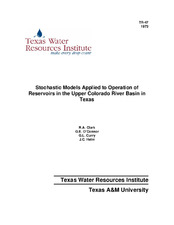| dc.description.abstract | A hydrometeorological model is presented that utilizes 30-day meteorological forecasts of temperature and precipitation issued every 15 days by the National Weather service to provide an estimate of the future hydrometeorological conditions of a river basin. The model is entitled "Monthly Operational Hydrometeorological Simulator (MOHS)." Use of the 30-day meteorological forecast categories of light, moderate, or heavy precipitation and below normal, near normal, or above normal temperature provide physical constraints upon quantitative values which were synthesized by a Monte-Carlo simulation technique. Estimates of monthly precipitation for meteorological stations semi-randomly located within the river basin are simulated from the square-root-normal distribution, while monthly mean data of ambient-air temperature are simulated using the Gaussian distribution. This initial simulation assumed a "perfect" forecast.
Contingency tables of forecast versus observed weather for the 24 forecast periods per year were obtained. It was demonstrated that, in general, the forecast periods of temperature provided information that verified better than chance. The precipitation periods did not verify as well. The contingency tables also provided conditional probabilities for each forecast category and period. These then were used to calculate an "expected value" forecast of temperature and precipitation for each station by assuming an "imperfect" forecast. Both simulation methods used an objective analysis scheme that fitted the station data to a rectangular grid-coordinate system. The analyses reproduced the rainfall and temperature patterns well and facilitated computations of surface runoff, reservoir evaporation, and consumptive-use by crops.
Three reservoirs located in the Concho River basin in west Texas were modeled and tested in this study. The reservoir system was described by a system of linear equations to provide some measure of the operational efficiency of the system. The purpose of MOHS is to provide information about hydrometeorological uncertainties which affect the decision-making process involved in water resources management.
The results indicate that the model provides valuable information when "expected value" forecasts are used. The validity of these results rests upon obtaining a more reliable rainfall-runoff relationship that will provide accurate estimates of streamflow. Monthly precipitation values are not representative of the intensity and duration of rainfall events which greatly influence the quantity of surface runoff. It is suggested that simulation of individual storm events be included in MOHS to improve the estimates of streamflow. | en |


